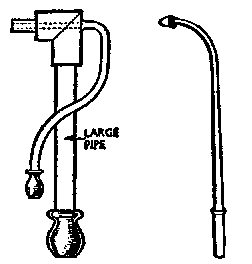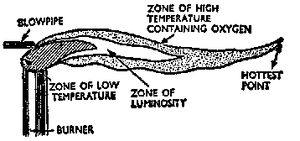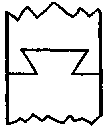
Brazing or hard soldering is the joining of metallic surfaces by an interposed alloy film. This type of soldering is used on metalwork to give a stronger joint than could be obtained by soft soldering. The surfaces to be brazed must be carefully cleaned, every trace of grease removed. As a cleaning agent, carbon tetrachloride is recommended Gasoline is not very suitable, as parts cleaned will retain a residual oil film.
A typical small-shop job is the brazing of tungsten-carbide tips on mild steel shanks. For tools of large section, the tip should be set in its place on the shank, after a sliver or thin sheet of electrolytic copper, together with a small amount of unfused borax, have been laid on.
The entire job must then be heated, and this can be done in a furnace, or with a blowtorch or blowpipe. A cold tip should not be placed directly into fierce heat, as this may cause it to crack. When the copper melts, the tip should be moved a little on its seat to make sure of a satisfactory joint. After this, the tool should be removed from the heat and the tip pressed gently into place. The tool must then be dipped in either powdered. electrode carbon or charcoal, to ensure slow cooling without contact with the air.
An alternative method is to preheat the shank to about 1500-1800 degrees F., withdraw the tool, and clean the seat with a wire brush. Borax, copper, and tip are then placed in position and the heat reapplied. Heating is continued, until the copper melts, and. the same procedure as outlined above then followed.
Preparation[edit | edit source]
In ordinary forms of brazing, the joints are cleansed with a file, followed by emery paper. Should it be necessary, they are then bound together with thin iron wire, or, if this method is inadequate, with clips. 4 flux of borax and water made into a stiff paste is applied to the joint, which is then gently heated to eliminate moisture. The metal is then raised to a white heat, end the brazing alloy or spelter plunged into the flux and applied to the joint. The spelter is rubbed on the metal until the spelter melts and. begins to flow. Heat is then withdrawn.

It is wise to cover almost the whole of the part being brazed with heat-conserving coke breeze or asbestos blocks. Small parts can be rested on an asbestos sheet.
Using a Blowpipe[edit | edit source]
The work should be so bound that it can be reversed. or moved during the operation without upsetting the relation of the parts. This facilitates flux and spelter application. The mouth blowpipe or the foot-bellows blow- pipe can both be used for brazing, as can the gas blowpipe (Fig. 1). The former should be blown gently, as continuity of air current must be sustained. Breathing should be through the nostrils and normal, but the cheeks should be tightly inflated. to give a steady pressure when blowing. The flame is obtained by holding the blast end of the blowpipe immediately over the source of heat – e.g., bunsen burner or alcohol flame, the tip of which it just contacts. The blast then throws forward a long bluish flame which is hottest at its tip (see Fig. 1 and 2). The foot-bellows is employed mainly for heavier work. A small gap must be left between the parts to be joined, but this is seldom more than a few thousandths of an inch and, in fact, a better joint is nearly always obtained when this clearance has been reduced to the barest minimum.
Fluxes[edit | edit source]
The brazing heat speedily oxidizes the metallic surfaces of the joint if exposed to the air; hence, the use of flux, which can be either dry, paste, or a hot saturated solution. In the last two instances it is best applied by brush, to ensure greater uniformity. If the flux is powdered. or granulated, it is usually mixed with the brazing alloy. In brazing strip, wire, or rods, the ends to be joined should be dipped in a small can of flux paste, or dry flux may be sprinkled on them.
Silver Soldering[edit | edit source]
Silver soldering is a form of brazing used for most nonferrous metals and alloys, as well as for steel and iron, the flux being either borax or boric acid, or a combination of the two. The commercial fluxes on the market usually contain halogen salts or phosphates. For brazing stainless steel, which is much more difficult than soldering the same material, ground borax glass is the best flux. Fused borax is suitable for brazing proper. A clip for holding and applying the solder is shown in Fig. 3.

The spelter is best in wire or stick form, as powder is likely to he scattered by air currents or the blast. Brazing spelters are usually of brass, and different compositions are necessary for the various types of metal, iron, brass, steel, copper, etc. If exceptional hardness in the joint is required, a little silver is sometimes added.


Parts to be brazed can not only be heated by the mouth blowpipe or the foot-bellows blowpipe, but also by immersion in an alloy bath (called dip brazing); in the furnace; and by electrical resistance. This last is used mainly for parts of smaller diameter or where a thin layer of the spelter can be inserted in the joint.
In brazing metallic sheets, where very little forming work has to be carried out later, it is possible to join the seams edge to edge. If this is done, small nicks should be made along the edges with a file, separated by distances of about ½ inch, as shown in Fig. 4. These enable the solder to flow through them and make a sound joint.
If any forming work has to be done after the parts are brazed, this method cannot be used, and it will be necessary to have the edges over- lapping. In making a joint of this type, the edges must first be thinned along the ends which are to make up the seams, about half an inch from the edge. By doing this, the overlapping of the two edges will make only a thickness equivalent to one thickness of the sheet. A small cramp must be cut in the top and bottom of the seam and the opposite edge fitted in. Then the parts should be securely fastened with wire to keep the joint firm.